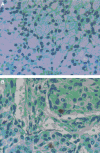TUNEL - an efficient prognosis predictor of salivary malignancies
- PMID: 17325701
- PMCID: PMC2360125
- DOI: 10.1038/sj.bjc.6603655
TUNEL - an efficient prognosis predictor of salivary malignancies
Abstract
Biological markers are necessary for predicting prognosis of salivary malignancies and better understanding the pathogenesis of salivary cancer. We analysed terminal deoxynucleotidyl transferase (TdT)-mediated biotinylated deoxyuridine-triphosphate (dUTP)-biotin nick-end labelling (TUNEL), p53 and Ki67 expression in 66 patients with malignant salivary tumours by immonohistochemistry, and correlated the data with survival, disease-free survival, tumour grade, stage, and local and distant metastasis. TUNEL efficiently predicted poor prognosis in salivary malignancies. The 5-year (5Y) survival probability dropped significantly with the level of TUNEL staining (from 83% in negatively stained tumours to 57 and 24% in TUNEL positively stained levels 1 and 2, respectively), (P=0.042). Extensive Ki67 staining (in addition to TUNEL) reduced the 5Y-survival rate even further and addition of positively stained p53 dropped the 5Y-survival rate to 0. The correlation rates between TUNEL and Ki67 was 58% (P=0.0001), and between TUNEL and p53 it was 50% (P=0.035). Concurrently, TUNEL correlated with metastasis, extracapsular spread, grade and stage. The correlation between TUNEL, p53 and Ki67 staining and survival probabilities, and the pathological grade, stage and metastasis spread of salivary malignancies makes this a highly effective tool in patient follow-up and prognosis.
Figures



Similar articles
-
The expression and prognostic significance of Cks1 in salivary cancer.Cancer Invest. 2009 Jun;27(5):512-20. doi: 10.1080/07357900802239116. Cancer Invest. 2009. PMID: 19296297
-
The salivary tip of the p53 mutagenesis iceberg: novel insights.Cancer Biomark. 2009;5(1):23-31. doi: 10.3233/CBM-2009-0567. Cancer Biomark. 2009. PMID: 19242059
-
TUNEL as a tumor marker of tongue cancer.Anticancer Res. 2008 Sep-Oct;28(5B):2981-6. Anticancer Res. 2008. PMID: 19031943
-
Mucoepidermoid carcinoma of minor salivary glands: a clinical study of 16 cases and review of the literature.Oral Dis. 2006 Jul;12(4):364-70. doi: 10.1111/j.1601-0825.2005.01166.x. Oral Dis. 2006. PMID: 16792720 Review.
-
Prognostic significance of p53 immunohistochemical expression in adenoid cystic carcinoma of the salivary glands: a meta-analysis.Oncotarget. 2017 Apr 25;8(17):29458-29473. doi: 10.18632/oncotarget.15297. Oncotarget. 2017. PMID: 28206977 Free PMC article. Review.
Cited by
-
Apoptosis index correlates with chemotherapy efficacy and predicts the survival of patients with gastric cancer.Tumour Biol. 2012 Aug;33(4):1151-8. doi: 10.1007/s13277-012-0357-8. Epub 2012 Mar 1. Tumour Biol. 2012. PMID: 22383294
-
Treatment and survival outcomes based on histologic grading in patients with head and neck mucoepidermoid carcinoma.Cancer. 2008 Oct 15;113(8):2082-9. doi: 10.1002/cncr.23825. Cancer. 2008. PMID: 18720358 Free PMC article.
-
Clearance of apoptotic cells by neutrophils in inflammation and cancer.Cell Death Discov. 2024 Jan 13;10(1):26. doi: 10.1038/s41420-024-01809-7. Cell Death Discov. 2024. PMID: 38218739 Free PMC article. Review.
-
Parotid carcinoma: Current diagnostic workup and treatment.Indian J Surg Oncol. 2010 Apr;1(2):96-111. doi: 10.1007/s13193-010-0022-x. Epub 2010 Nov 21. Indian J Surg Oncol. 2010. PMID: 22930624 Free PMC article.
-
p27 and salivary cancer.Cancer Immunol Immunother. 2009 Mar;58(3):469-73. doi: 10.1007/s00262-008-0547-9. Epub 2008 Jul 29. Cancer Immunol Immunother. 2009. PMID: 18663445 Free PMC article.
References
-
- Batsakis JG (1980) Salivary gland neoplasia: an outcome of modified morphogenesis and cytodifferentiation. Oral Surg Oral Med Oral Pathol 49: 229–232 - PubMed
-
- Batsakis JG (1999) Surgical excision margins: a pathologist's persepctive. Adv Anat Pathol 6: 140–148 - PubMed
-
- Batsakis JG, Regezi JA, Luna MA, El-Naggar Ak (1989) histogenesis of salivary gland neoplasms: a postulate with prognostic implications. J Laryngol Otol 103: 939–944 - PubMed
-
- Ben-Izhak O, Bejar J, Ben-Eliezer S, Vlodavsky E (2001) Splenic littoral cell haemangioendothelioma: a new low-grade variant of malignant littoral cell tumour. Histopathology 39: 469–475 - PubMed
MeSH terms
Substances
LinkOut - more resources
Full Text Sources
Medical
Research Materials
Miscellaneous

